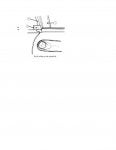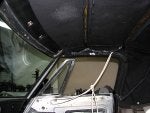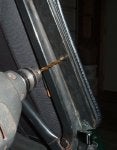Punching the holes is not terribly difficult with a wood block, 5/16" hole punch, and a mallet.
However, it's a tedious process to locate the hole sites. I draped the softtop at the rear trough as best as possible on center, and located how far up from the fabric bottom seam the holes would need to be to match the metal strip; then used a mark-a-lot broad tip to show that line area. By using a paint marking pen to paint the top of each stud and touching the fabric to the stud, in turn, I was able to punch a hole and then secure that portion of the softtop with a large fender washer and nut on the stud, then move to the next stud adjacent. Don't forget to leave a generous bit of fabric allowance around the large radius at the back corners, or you'll have a wrinkle as the softtop tries to stretch into the bend with the metal strip forcing it into position.
Did I mention this was a tedious project? It took awhile to mark and punch all the stud holes, and then I had to remove the temporary fasteners so that the metal strips, top, and drape fabric were installed. I started securing all with the side strips first, and then the back strip. It is possible to make a "mistake" in locating a hole, but if you are careful and conservative about where you locate and punch the holes, you should have enough material left to re-locate and punch a hole without it showing or becoming a drastic problem with a ruined softtop.
By locating the holes at the furthest down position, I was barely able to have enough "top" material going forward to allow the softop to reach the front windshield and latch the top. I had to leave the car outside in a 85F day with bright sunshine (we're at 6,000' elevation) for several hours and keep re-trying to close the top. On my fourth try, the top finally eased enough to allow me to get the latches started, and then an hour later, I was able to push the front of the softtop down enough to the window frame to allow the latches to close. The top was tighter than a banjo, and a few more hours in the sun only started to ease the tension enough that I could start positioning and gluing into place the window pillar flaps and soft portion.
I found that I couldn't trust my dry runs to locate where the metal strip was to be glued into place for the three rivet holes to line up and have the window contact area closely located to the softtop frame. So, I located the metal strips in place on the fabric, lined up the holes, and secured all with some clamps, leaving enough of the fold over material exposed that I was able to glue in a small area to hold the flap. I then glued the back side (folded over portion), and then glued the main surface of the metal. This was a couple more steps than shown in this thread by the OP, but my procedure was rewarded by having the 3 rivet holes all line up on the first try and I was able to set the pop rivets without any difficulty. The edge of the metal strip is snug against the seam of the soft area.
Would I buy this (lower) quality vinyl top again for my next softtop project? No way. The extra money for a better quality top is money well spent when your labor is dear.
On the top I bought, two of the fixed positon bows do not match where the securing fabric strips are located, so I had to "extend" the fabric a bit with some scrap material.
Also, the panels that seal against the door window openings do not have uniform overlap to the windows, although I believe they will seal adequately ... given that this car is a 3-season car and we don't get a lot of rainstorms, although it's likely that I'll get caught out in a heavy downpour in the mountains a few times a season. While I enjoy driving a roadster, the reality of driving around here is that there's so much airborne particulates ... dust, plant matter, pollens, and dirt ... that my eyes get sandblasted every time I drive around here with the top down and the windows rolled down. So I'll most likely drive this car with the softtop up until I travel out of the area (SE Wyoming) to the Colorado mountains where the particulates aren't so plentiful.









